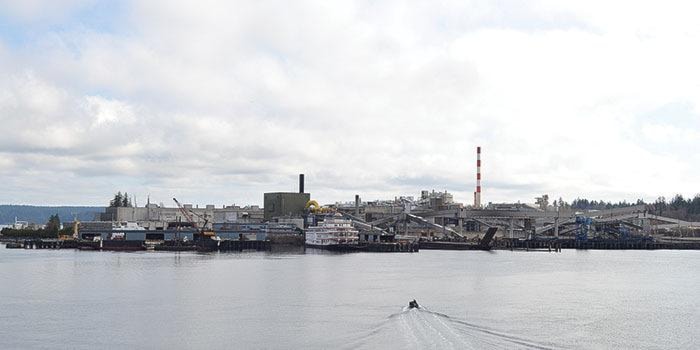With the purchase in May 2013 of the old Elk Falls Mill property, a 400-acre Catalyst Paper industrial site and its adjacent property just north of Campbell River, Quicksilver Resources has set its sights on a Liquefied Natural Gas (LNG) plant, which would cool the natural gas from Quicksilver’s Northeast B.C. Horn River Basin sites – and other areas – for transport to Asia.
Expected by Quicksilver to be operational by 2021, and at full operation levels by 2024, the operation still has some significant hurdles to take on, however.
Though Quicksilver has recently applied to the National Energy Board (NEB) for license to export up to 470 million tonnes of LNG over 25 years, that application itself states that Quicksilver is only at the “project feasibility stage,” of their planning, having yet to determine, “supply and market participants to develop commercial supply and offtake agreements,” meaning they’re applying to see if they will be permitted to export the product and whether anyone will buy it from them if they get that permission—before they decide they want to produce the product.
They also state on the application that the license sought is meant to cover the operation of the site and transport of the resource under, “a variety of multi-party arrangements, including but not necessarily limited to, incorporated joint ventures, unincorporated joint ventures or partnerships, all of which will include the applicant in their overall structure,” and that these arrangements are also only in the, “searching for potential partnerships,” phase, meaning they don’t have the financial resources to go ahead with the project, and they don’t have others on board to make up for that financial shortfall yet.
The natural gas also needs to get to the Campbell River facility before it can be processed, which currently is proposed to happen, “by a yet-to be determined transportation method,” meaning they don’t currently have a way to do that, either.
So the NEB export permit is just one of many stages of the development process.
Now that the permit application is in to see if they’ll be allowed to sell the final product to international markets, Quicksilver is waiting on possibly the most crucial step of the process – that being the provincial and federal government figuring out a taxation and fiscal structure for the LNG industry in general.
“Without the tax and fiscal structure in place, you can’t get any of these projects going,” according to Dave Rushford, senior vice president and chief operating officer of Quicksilver, who says that, as of now, they’re focusing their efforts on developing the markets for the prospective product and continuing the reclamation project on the old mill site.
“Catalyst ran a very clean operation, so we’re not finding any contamination that will delay or prevent any of our development on the site,” Rushford said, adding that as the reclamation process continues, Quicksilver will begin the environmental studies of the surrounding marine environment, as well, so as to have that information thoroughly examined and analyzed by the time they are prepared to put forth a final proposal down the road.
Despite all the possible roadblocks, Rushford and Quicksilver are optimistic and enthusiastic about the prospect of a facility at the site.
“From our perspective,” Rushford said, “this is an incredible project for Campbell River,” adding that because of the location of the site, little work – in relation to the total process – will be required to prepare it for an LNG plant, and when you combine that with the plentiful availability of industrially-trained employees in the region, Rushford said the forecast is good for the operation, and they aren’t considering, at this point, any other sites.
